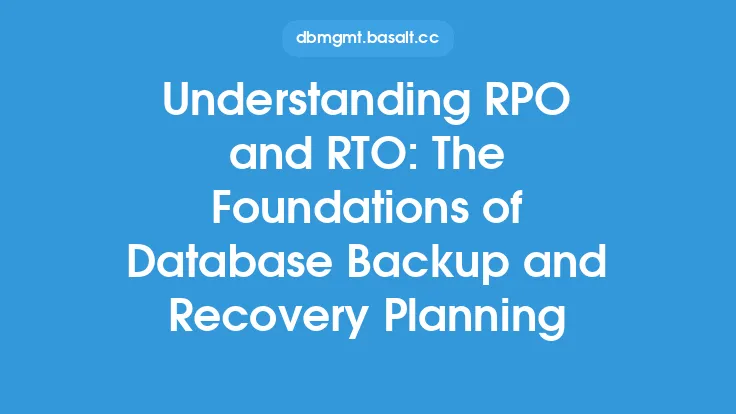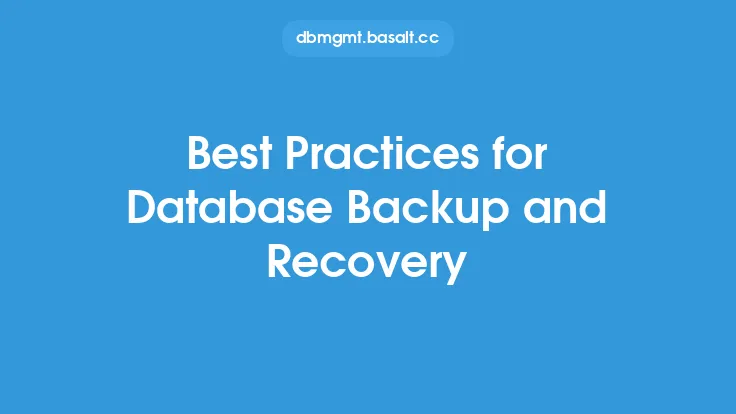When it comes to database backup and recovery, two crucial metrics play a significant role in determining the effectiveness of a database's backup and recovery strategy: Recovery Point Objective (RPO) and Recovery Time Objective (RTO). These metrics are essential in ensuring that a database can recover from a disaster or data loss event with minimal impact on the business. In this article, we will explore how RPO and RTO influence database backup and recovery strategies, and provide insights into how these metrics can be used to develop a robust and reliable backup and recovery plan.
Introduction to RPO and RTO
RPO and RTO are two related but distinct metrics that are used to measure the effectiveness of a database's backup and recovery strategy. RPO refers to the maximum amount of data that can be lost in the event of a disaster or data loss event, while RTO refers to the maximum amount of time that it takes to recover the database to a usable state. In other words, RPO is concerned with the amount of data that can be lost, while RTO is concerned with the time it takes to recover the database. Understanding these metrics is crucial in developing a backup and recovery strategy that meets the needs of the business.
Impact of RPO on Database Backup Strategies
RPO has a significant impact on database backup strategies. A lower RPO value means that less data can be lost in the event of a disaster or data loss event, which requires more frequent backups. This can be achieved through a variety of means, including incremental backups, differential backups, and transaction log backups. The choice of backup strategy will depend on the RPO value, as well as the size and complexity of the database. For example, a database with a low RPO value may require more frequent incremental backups, while a database with a higher RPO value may be able to use less frequent differential backups.
Impact of RTO on Database Recovery Strategies
RTO, on the other hand, has a significant impact on database recovery strategies. A lower RTO value means that the database must be recovered more quickly, which requires a more robust and efficient recovery strategy. This can be achieved through a variety of means, including the use of high-performance storage, optimized database configuration, and automated recovery scripts. The choice of recovery strategy will depend on the RTO value, as well as the size and complexity of the database. For example, a database with a low RTO value may require the use of high-performance storage and optimized database configuration to ensure rapid recovery, while a database with a higher RTO value may be able to use more traditional recovery methods.
Balancing RPO and RTO
Balancing RPO and RTO is critical in developing a robust and reliable backup and recovery strategy. A lower RPO value may require more frequent backups, which can increase the time it takes to recover the database. On the other hand, a lower RTO value may require a more robust and efficient recovery strategy, which can increase the cost and complexity of the backup and recovery process. Therefore, it is essential to balance RPO and RTO to ensure that the backup and recovery strategy meets the needs of the business, while also being cost-effective and efficient.
Considerations for Database Backup and Recovery
When developing a database backup and recovery strategy, there are several considerations that must be taken into account. These include the size and complexity of the database, the RPO and RTO values, the type of data being stored, and the business requirements for data availability and recoverability. Additionally, the backup and recovery strategy must be tested and validated regularly to ensure that it is effective and reliable. This can be achieved through regular backup and recovery exercises, as well as the use of automated testing and validation tools.
Best Practices for RPO and RTO Planning
There are several best practices that can be followed when planning RPO and RTO values. These include conducting regular business impact analyses to determine the RPO and RTO values, developing a comprehensive backup and recovery strategy that meets the RPO and RTO values, and testing and validating the backup and recovery strategy regularly. Additionally, it is essential to monitor and review the RPO and RTO values regularly to ensure that they remain relevant and effective. This can be achieved through regular reviews of the backup and recovery strategy, as well as the use of automated monitoring and reporting tools.
Conclusion
In conclusion, RPO and RTO are critical metrics that play a significant role in determining the effectiveness of a database's backup and recovery strategy. Understanding these metrics is essential in developing a robust and reliable backup and recovery plan that meets the needs of the business. By balancing RPO and RTO, and considering the size and complexity of the database, the type of data being stored, and the business requirements for data availability and recoverability, organizations can develop a comprehensive backup and recovery strategy that ensures the availability and recoverability of critical data. Regular testing and validation of the backup and recovery strategy, as well as monitoring and review of the RPO and RTO values, are also essential in ensuring that the strategy remains effective and reliable over time.





